SP+ predicted a 35-16 Notre Dame win at Louisville. The spread in Vegas was 18 points in many places. But the Irish win to open 2019 didn’t feel particularly fun, did it? Breaking down reasons to be encouraged, concerned, and confused using advanced stats from the season opener.
Something not clear? Check out this handy advanced stats glossary.
In the past I’ve taken a very liberal approach with garbage time, but in this game I did not end up throwing out any snaps. SP+ currently defines garbage time as a lead of 22 points or more in the 4th quarter, which wasn’t met, and in this game the last few drives didn’t meaningfully sway the overall numbers one way or another.
Explosiveness
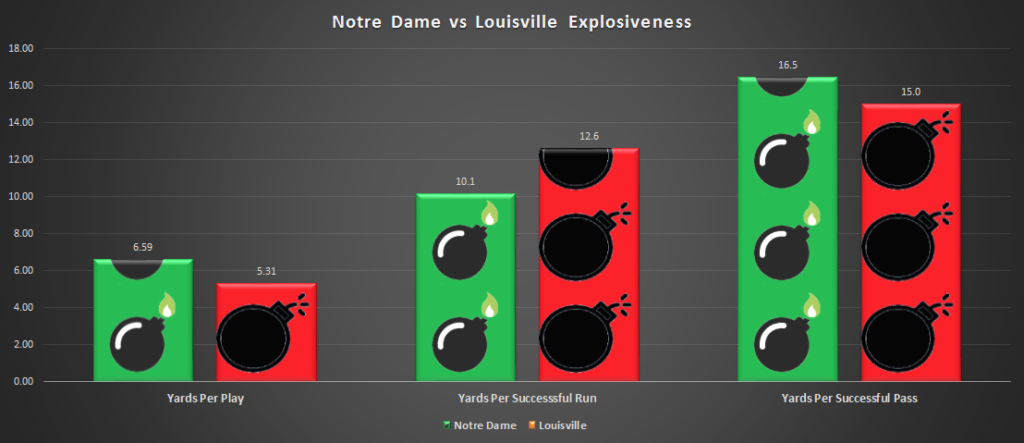
On the surface, out-gaining a Louisville projected to be one of the worst in the power five by 1.29 yards per play qualifies as below expectations. After an eventful first quarter, it was a virtual deadlock in YPP, with both offenses well above 7.5 YPP. If the real Irish defense is the team that showed up after those first two Louisville drives, however, the numbers look far more palatable, with the Cardinals struggling to string drives together and hold onto the football. Clark Lea has to wonder if without a couple early offsides penalties this is a single-digit defensive effort that leaves everyone fans feeling much optimistic defensively.
| Louisville YPP | Louisville Success Rate | |
| First Quarter | 7.75 | 50% |
| Rest of Game | 4.42 | 31% |
The offense felt clunky for much of the game, yet 6.59 yards per play would have been the 5th highest mark in the 2018 season, and was closest numerically to the feel-good breakout against Stanford last year (6.58 YPP). Despite early inaccuracy and some happy feet in the pocket, the Notre Dame pass game still ended up averaging a solid 7.54 yards per attempt (including sacks).
The film behind those numbers is not as positive, as there were many drop backs that didn’t end in a pass attempt at all. Of Book’s final 17 called passes in the game, beginning with 3:37 left in the 2nd quarter, he scrambled on six attempts and had three throwaways (including the viral 4th quarter heave that nailed a Cardinal cheerleader). For the game four of eight Book scrambles were successful plays, including the 37 yarder to start the game, but five gained four yards or fewer, including the lost fumble when Book ran into Brock Wright.
Ian Book with a beautiful pass to a cheerleader’s face pic.twitter.com/YTrxFUWKeQ
— NOTSportsCenter (@NOTSportsCenter) September 3, 2019
It appeared to be a vanilla gameplan from Chip Long – minimal screen passes, no downfield throws, little misdirection – that against an inferior opponent should have worked. But with Jafar Armstrong now slated to miss significant time, it raises a lot of questions about Notre Dame’s skill position talent. Yes, Cole Kmet and Michael Young were missed, but there’s no satisfying explanations for Book’s struggles with good protection. Armstrong’s absence puts more pressure on Book and Long – it takes away the most explosive back on the roster, a versatile cog in many two-back personnel groups and plays, and a trusted veteran picking up blitzes.
Teams will continue to pressure Book from a variety of places, hoping to encourage more discomfort in the pocket and daring him to beat them downfield and make them pay for their aggression. And with few field-stretching options currently available, it may not take a great defense to limit this offense. A potentially triggering question that crossed my mind Monday night – what is the best defense Ian Book has beaten? Hopefully this is a blip on the radar of a long season, but this could be the reality of the Book-led offense – streaks of brilliance marred by periods of confusion and inconsistency.
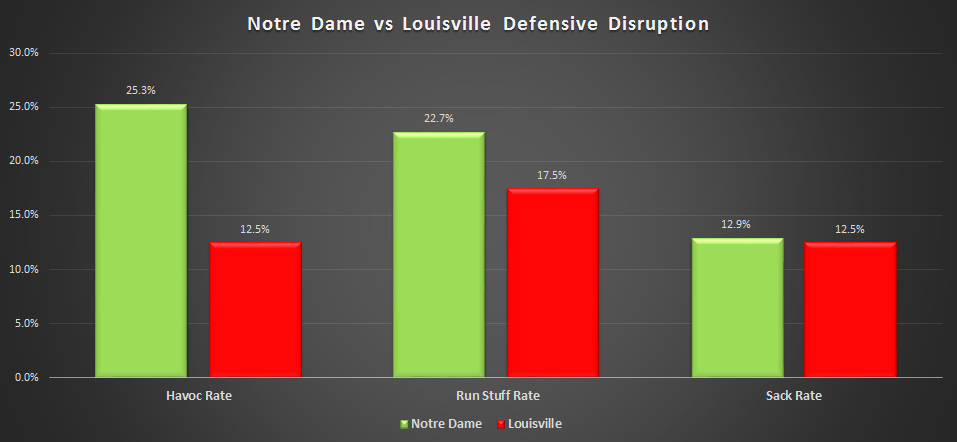
Limiting explosive plays defensively has been a hallmark of Clark Lea (and before him, Mike Elko in the same scheme) and remains an area to keep an eye on. The Irish allowed 12 runs of 10+ yards at Louisville, fifth most of any FBS team in an opener, including one of 40+ when they allowed just three such runs in 13 games last year.
It was an extremely strong performance in havoc for the Irish defense, with 11 tackles for a loss (tied for 8th highest of any FBS team) and 5 pass break-ups. The aggression level and balance between disrupting the run given relatively personnel weakness there and playing more of a bend but don’t break style will be firmly under the microscope moving forward, especially against opponents that complement the run with more of a passing threat.
Efficiency
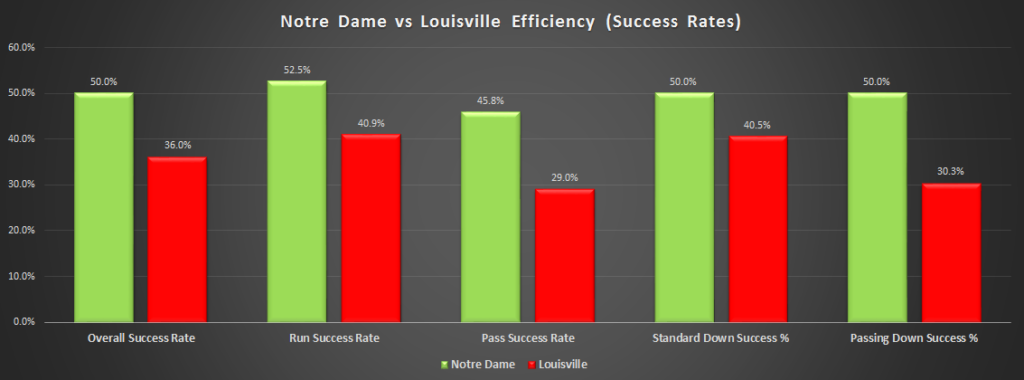
The Irish offense rode the strength of the running game to big edge in efficiency, an encouraging sign for a ground attack that struggled in this area a year ago. Notre Dame was successful on 52.5% of runs (average efficiency rate is about 40% running or passing), a mark which they eclipsed just twice last year (against Wake Forest and Navy). And despite all of Book’s inconsistency the pass game still managed above average efficiency as well – really a necessity with the lack of downfield throws (none over 20+ yards in the air).
Notre Dame didn’t face too many passing downs (2nd and 8+, 3rd and 5+) but converted successful plays on half of them. Average success rates drop from 40% to 30% on passing downs, but the Irish offense was equally efficient in those situations. The run game again was the fuel as the Irish picked up big gains in situations usually set up for passes, including:
- a 15-yard run from Tony Jones Jr. on 2nd and 10
- A 35-yard run from Jones on 3rd and 13
- A 12-yard Jahmir Smith run on 2nd and 10
- The massive 11-yard touchdown run from Book on a QB draw on 3rd and goal
While the run game was extremely good on passing downs with many yards to go, they surprisingly struggled on short distances. On power run plays, defined as 3rd and 4th and 2 yards or fewer to go, the Irish were 0 for 3. Chip Long’s offense converted those runs 78% of the time in 2018, 23rd best in FBS.

The ND defense had a better day defending the pass (the man and play type), allowing just 4.1 yards per attempt versus a worrisome 6.16 yards per rush. Heading into the season the run defense was definitely the bigger worry given the loss of Jerry Tillery, Drue Tranquill, and Te’von Coney. There was certainly some confusion and uncertainty with Scott Satterfield’s new scheme early, with some flashes of brilliance (hello Wu!) intermingled with missed assignments. I think the results were a bit kinder than the overall performance in the passing defense, but you have to give credit for the right type of adjustments and forcing the Cardinal to eventually beat the Irish with their weakness.
After settling in, the Irish defense consistently held Louisville to only sputtering progress. For the game the Cardinals gained just 2.4 yards per play on 1st downs, and averaged 11 yards to go on third down attempts. Pass and the offense faced 33 passing downs and 42 standard downs, constantly losing leverage with a lack of early down success.
Finishing Drives, Field Position, & Turnovers
In a game at times Notre Dame played down the level of its opponent, sometimes simply doing the little things right can make a difference, and the Irish dominated the final three “Five Factors” categories.
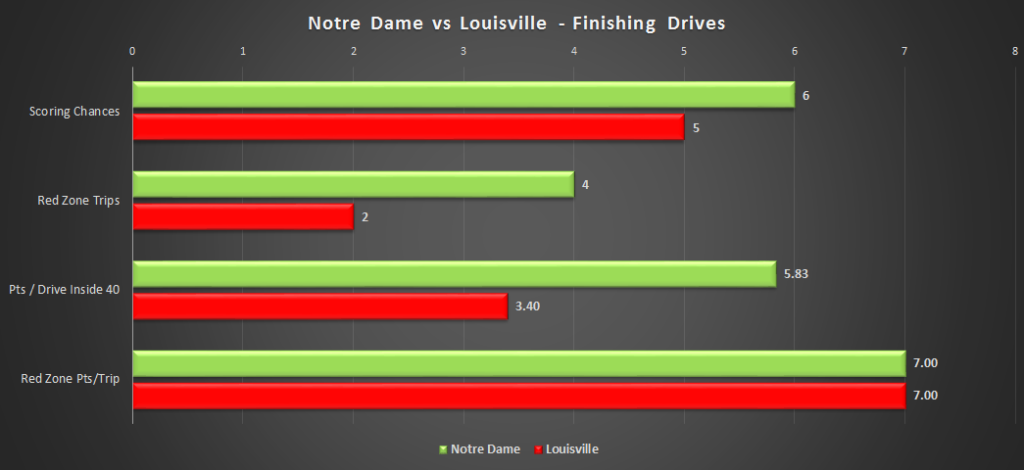
The Irish created just one more scoring opportunity, defined by a first down inside the opponent’s 40-yard line, than Louisville, but scored touchdowns on five of six chances. The one failure to convert was the Ian Book fumble, which was promptly returned back by a botched snap.
Notre Dame also won the average starting field position battle by a whopping 12 yards, buoyed by the two 2nd quarter fumbles deep in Louisville territory and a late turnover on downs. The best starting position for the Cardinal offense was their own 36 after the Irish failed to convert a 4th down on an errant throw to Chris Finke.
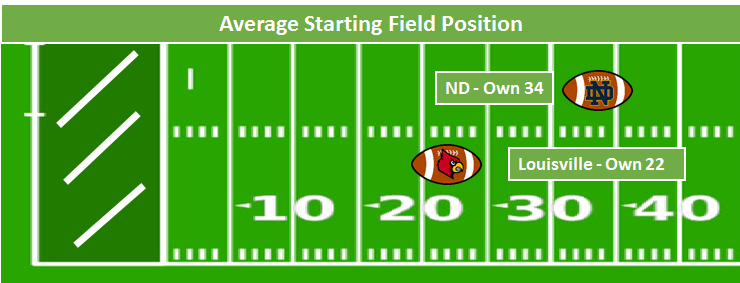
It felt a bit lucky that Louisville kept losing control the football, but statistically ND didn’t benefit from a ton of turnover luck (miss you, Bill C. advanced stat excel sheets!). Of the seven (!) fumbles available, the Irish recovered four, and didn’t have an interception off of five pass breakups (you’d over time expect about 20% to result in a pick). In contrast, Book (for better or worse) rarely put the ball in danger, with just two Cardinal pass deflections – an early tip at the line and a 3rd down miscommunication with Finke that glanced off a Louisville defender.
“Never easy”
In both wins and losses, “never easy” has been one of my go-to mutterings watching Notre Dame football. It sadly characterized much of my tenure as a student in the Weis era, and transitioned naturally into the beginning of Brian Kelly’s, when the Irish seemed to play more one-possession games than almost any other program.
In the course of the long offseason, and especially the after-glow of 12-1, it’s easy to forget that painless and drama-free wins are the exception, not the rule, even against bad teams (and we aren’t 100% sure how bad Louisville will be under Satterfield). Everyone remembers Ball State and Vanderbilt last season, but Pittsburgh was gross, Northwestern was exceedingly frustrating at times, and the Stanford/USC/Virginia Tech trio of games were blood-pressure raising affairs before Notre Dame pulled away late.
Usually the post-game locker room coach-speak is better entertainment value than philosophy, but Brian Kelly’s “we went on the road and started to find out about ourselves” rang very true to me. Week one is always prime territory for over-indexing on 70 plays or so on each side of the ball, but certainly challenges some assumptions about this team.
Is the potential offensive floor lower than expected if the skill position injuries continue to mount? Is the run defense going to be reliable against good teams? Can the pass rush live up to the hype? Can the secondary be filled with difference makers if Kyle Hamilton and Shaun Crawford keep showing out? Unfortunately many of these questions won’t truly be answered for a few weeks until a terrifyingly huge night game in Athens, but there may be some hints (and hopefully health regained) in the bye week and New Mexico games on the way.

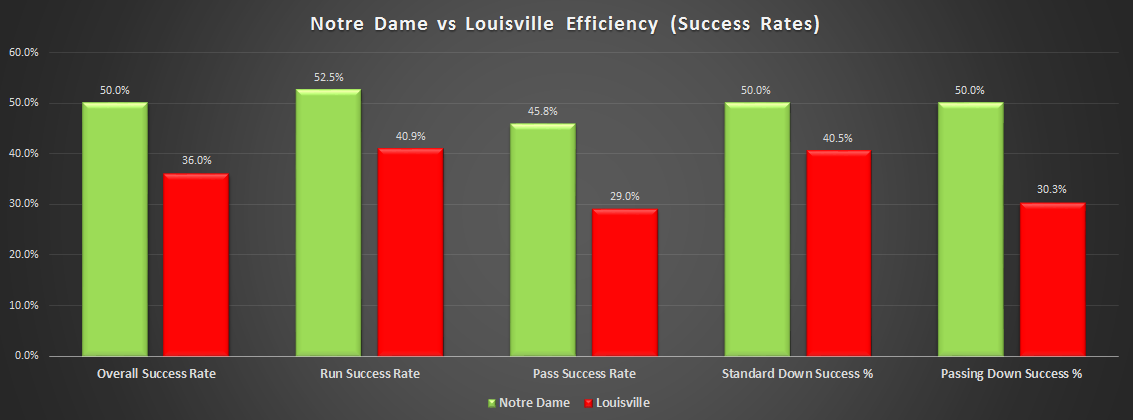



Awesome material as always. Thanks for your hard work putting it all together.
I didn’t want it to get lost that Jones’ long rush on 3rd down was a tremendous play-call.